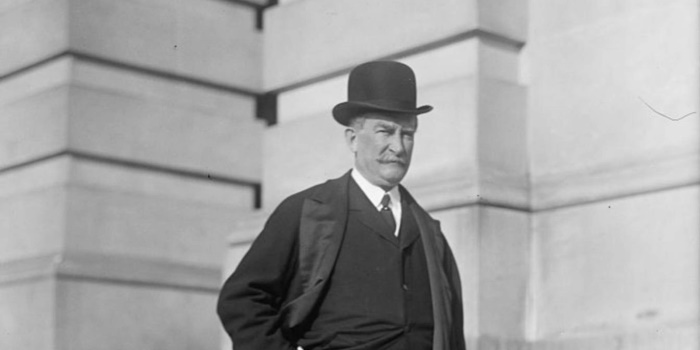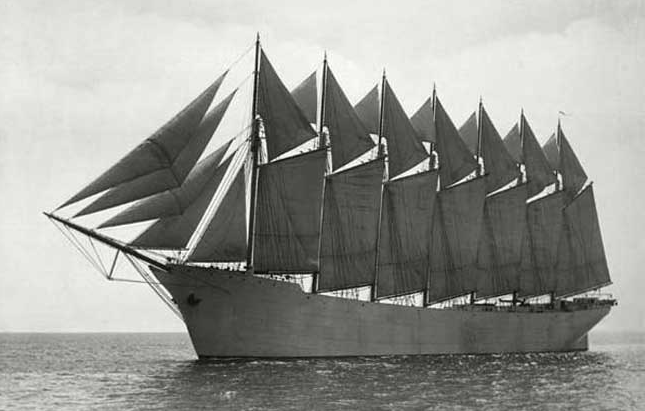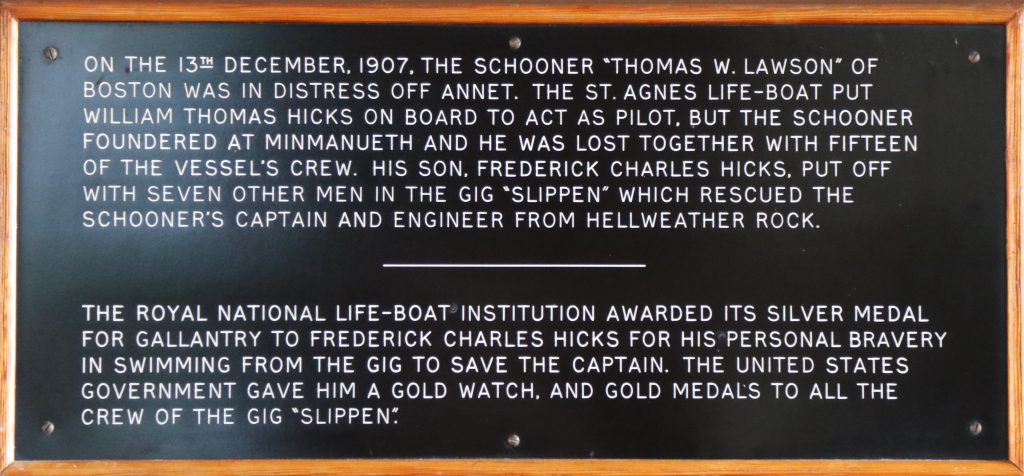
December 14, 1907 – The wreck of a huge American sailing ship at the Isles of Scilly, involving the loss of many lives early Saturday morning (Dec. 14), augments the dreadful toll the seas have claimed. The story of how the largest sailing ship in the World was cut in twain among the rocks reveals a harrowing story of fate of those who went down with the Thomas W. Lawson, and of the three men who survived her until Sunday, when one of those failed to escape death. The doomed vessel was seven-masted and schooner, and the biggest sailing ship afloat. She belonged to Boston, Mass., U.S.A. and was built five years ago of steel, and was constructed especially to save labor in crew. She only carried a captain and crew of seventeen, Captain George W. Dow of Boston was her master, and she sailed from Philadelphia on November 20th last. The ship was valued at 400,000 dollars, and her cargo was worth approximately 200,000 dollars. The cargo consisted of oil, and it was computed that in bulk there were about 60,000 barrels. Her net tonnage was about 5,000 tons. From the start the vessel had a bad passage. In the words of the captain, it was blowing something wicked last Monday, Tuesday, and Wednesday week. She ran into a southerly gale and fared badly. Half the sails were blown away and a lifeboat and life raft lost, only a 20 ft. boat remaining. The whole of the deck fittings were smashed, including hatches and the cabin door, whilst the ship herself was badly strained.

The Thomas W. Lawson weathered that storm, only to meet as violent a one. On Friday last she made the Isles of Scilly, and the captain found he was too far to the leeward by a mile. There was no room to wear ship, and there was not sail enough to tack. The ship was, therefore, brought to and anchored. Her position was dangerous. She was in waters teeming with rocks and submerged ledges, between Nun Deeps and Gummers’ Ledge and in Broad Sound. This is inside Bishop Rock Lighthouse, which was first reported on the ship as a passing schooner. The Thomas W. Lawson, with two anchors out, faced the fury of a fierce northwest gale. Accompanying the gale were mountainous seas, and the ship could not have been in a worse position. She had been sighted from St. Agnes and St. Mary’s Islands, and realizing her extreme danger, the St. Agnes lifeboat was launched. The keepers on the lighthouse also saw her and fired signals. St. Mary’s lifeboat was being manned and launched at 4:25 by order of Mr. E. J. Bluett, Hon. Secretary of the local branch of the lifeboat institution. Both lifeboats had trying experiences as seas continuously broke over them. The St. Agnes boat was launched about four o’clock and reached the ship shortly after five. The captain was asked if he wanted assistance, and replied in the negative. Knowing the danger in which the vessel stood, the lifeboat men again asked, and got alongside. Captain Dow then requested the services of a pilot. One of the lifeboat crew, William Cook Hicks a well-known Trinity pilot went aboard, but all that could be done was to wait for moderation of weather. The lifeboat stood by the ship. St. Mary’s lifeboat afterwards arrived, and in attempting to get alongside, got under the quarter of the vessel and carried away her mast. She returned to St. Mary’s to repair the damage and to send telegrams to Falmouth for tugs. The reply from Falmouth was that the tugs left at 10:20 on Friday night. The tugs never arrived, evidently finding the gale too fierce to face. The St. Agnes boat had to leave the ship in order to take ashore one of their crew who had suffered from exposure. It was feared he was dead, but restoration was brought about when he was taken ashore. Hicks, the pilot on board, was informed, and told that should anything untoward happen he was to burn flare. Neither of the lifeboats went back. A sharp lookout was kept from various points. At 2:30 on Saturday morning the ship’s lights disappeared. As the gale had heightened, it was thought at St. Agnes that the lights had been accidentally extinguished. Little did the watchers realize that the Thomas Lawson had gone to her doom, and that of the nineteen souls aboard, including one of their own mates, only three were at that time struggling from death to tell the tale of the tragic fate of the ship.
How the Ship met it’s Fate
The Thomas Lawson broke an anchor, unable to stand the hurricane, and, dragging the other, crashed into the rocks. The officers and pilot were in the mizzen-rigging lashed between two and three o’clock, and the remainder were scattered in different parts of the ship, the chief on the forecastle head. The ship struck broadside on, smashing in the starboard side, and causing rigging to sag until the seven masts began to sway with the motion of the vessel as she was buffeted by huge seas. It was a desperate and awful time. The engineer, Edward Rowe of Boston, was by the side of the pilot, and when the huge craft trembled from end to end as she was hurled against the rocks, he asked Hicks if there was a chance of getting ashore. Hicks knew every inch of that treacherous part, and replied, “No”. But strangely enough, that engineer is one of the survivors. Hicks, to the regret of all Scillonians, is missing, and is undoubtedly dead. The end of the ship came swiftly. She only struck once more, and then came destruction. Masts and rigging crashed into the sea, and the stem was cut right off. The cargo was freed, and thousands of gallons of oil poured out onto the sea. Every man had a life belt, but nearly all were either dragged down in the rigging, dashed against rocks, or perished in the horrible floating masses of oil.

The Survivors’ Terrible Plight
Out of the vortex came Captain Dow, Rowe, the engineer, and George Allen of Battersea. They had terrible hardships to pass through before finding a refuge on the rocks. Terrible privations followed in full exposure to the awful weather. For many hours those on the islands were still watching, ignorant of what had happened. Daybreak revealed no ship, but the almost overwhelming stench of oil told its own story. The lifeboat was not launched, the weather being too fearfully rough, and it was not thought advisable even to try to get her out at St. Agnes. The grownup son of pilot Hicks pleaded for an endeavor to launch the lifeboat when the lights of the ship disappeared. At daybreak, a crew volunteered to go out with a gig, and eight young St. Agnes men, including pilot Hicks’ son, heroically launched it. They landed on the uninhabited island of Annet, and then heard the faint shouting for help. A search revealed the sailor, Allen, suffering from exposure and internal injuries, trying to get shelter beneath a rock. He had been weathering the storm on the same shore as three of his mates, but they were dead. He saw them at daybreak, and evidently there was life in them then. He urged his rescuers to go to them as he was all right. Allen was borne to St. Agnes Island and placed under the roof of a hospitable farmer, Mr. Israel Hicks. Communication was set up with St. Mary’s, and St. Mary’s lifeboat took Dr. Brushfield to St. Agnes, and he attended the injured man. The doctor did not regard his recovery with any hopes. Allen was then apparently the sole survivor, and he had been taken from an island two miles from where the vessel had anchored and was left by lifeboats. Allen had been on the island about five hours, and was the last man washed off the vessel. The islanders almost gave up hope that any other man could be living on the rocks in the vicinity.
The Captain Rescued
The same crew, however, made another brave row to Annet Island, leaving St. Agnes about 2:30 Saturday afternoon, and they were rewarded by finding a man safe and well. On their way they saw the engineer on a rock at Helwethers Carn. They threw him a rope, and with its aid, he got through the surf and into the boat. Rowe then told them that the captain was on the rocks there helpless. How he got there, he did not know, but he discovered him in the night and dragged him up into comparative safety. Rowe himself was badly battered and suffering through swallowing salt water and oil. They took him ashore and went back to rescue the captain. Captain Dow undoubtedly owes his life to Fred Cook Hicks, a son of pilot Hicks who has not been found. They could not effect a landing, and Hicks thereupon took the rope and swam and scrambled through nearly fifty yards of sea and rock. His difficulties were not then over, as he found the captain helpless with wounds he had received through being tossed about, and with a broken wrist. Hicks securely fastened him with a rope, and managed to get him to the gig. Captain Dow was taken to the same house in which Allen and Rowe were sheltered and was attended, Dr. Brushfield being again taken out by the St. Mary’s lifeboat, and the lifeboat men searched the rocks to try and trace other men of the ship. On Sunday morning the St. Mary’s lifeboat and numerous gigs from the different islands made an examination of the rocks in the neighborhood, and recovered the headless body, it is believed, of one of the officers, and later the fifth body.
Death of Allen
Allen died on Sunday afternoon, so that the only survivors are the captain and the engineer. It is understood that the ship is not insured. Captain Robertson, one of Lloyd’s special surveyors, on Sunday morning went from Penzance to the Isles of Scilly on the Western Marine Salvage Co.’s boat, Lady of the Isles, with Captain Anderson, the well-known wreck-salver to inspect the position of the vessel. They visited the scene, and found at high water that it was not visible.
Bodies Recovered
Five bodies have been recovered. Three have been identified, those of Mark Simpson, cabin boy, Brooklyn: George Bolimke, seaman, a German: and Victor Hansell, a Swede. From one of the other bodies the head and arms are missing.
Description of the Vessel
The Thomas W Lawson was one of the most remarkable craft afloat. She had seven masts, and being entirely fore-and-aft rigged, was described as a schooner, carrying only spinnakers, gaff, topsails, and fore staysails. She was the biggest seven-masted schooner in the world, and had the distinctions of having a larger tonnage and deadweight capacity than any other American-owned ocean-going sailor. Her appearance at sea, when all her sails were set, was extraordinary. Not long ago she was badly damaged in a gale off the American coast. She eventually made her way to port, and only recently was completely refitted for sea. A peculiar item in her equipment was a small steam engine she carried to facilitate the handling of her immense sails, thus enabling her to do with a smaller crew than would otherwise have been required. She was built in 1902 by the Fore River Ship and Engineering Company of Quincy, Massachusetts for the Coastwise Transportation Company of Boston, U.S.A., and was of 5,218 gross tonnage, 5,006 underdeck, and 4,914 net tonnage.
Vessel Specifications:
Name: Thomas W. Lawson
Namesake: Thomas W. Lawson
Owner: Coastwise Transportation Co. (John G. Crowley), Boston
Route: US East coast coal trade; in 1907: transatlantic voyage to London
Ordered: June 25, 1901
Builder: Fore River Ship & Engine Building Co., Quincy, MA;
Naval architect: Bowdoin B. Crowninshield
Cost: $248,000 construction, total costs with oil cargo in 1907: ~$400,000
Yard number: 110
Laid down: November, 1901
Launched: July 10, 1902
Christened: July 10, 1902
Completed: August 1902
Maiden voyage: September 1902 via Philadelphia to Newport News, VA
Reinstated: 1906 as a tanker for oil in bulk
Homeport: Boston, MA
Fate: Sunk in a storm within the Isles of Scilly on Friday, December 13, 1907 with the loss of 17 men out of 19 including pilot
Status: Wreck
Badge: None; no figurehead
Sources:
The Western Weekly News, 21st December, 1907

